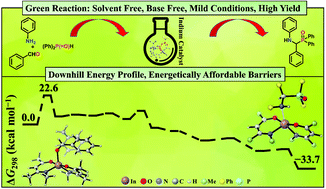Indium promoted C(sp3)–P bond formation by the Domino A3-coupling method – a combined experimental and computational study†
Abstract
A highly efficient and green process for the synthesis of α-aminophosphonates has been developed through a one-pot three-component reaction of various aldehydes, amines, and phosphine oxide in the presence of indium complexes as competent catalysts under neat conditions at room temperature. The indium complexes [κ2-{RNC(Me)![[double bond, length as m-dash]](https://www.rsc.org/images/entities/char_e001.gif) CHC(Me)
CHC(Me)![[double bond, length as m-dash]](https://www.rsc.org/images/entities/char_e001.gif) O}2InCl] (R = 2,6-diisopropylphenyl (Dipp), 2a; 2,4,6-trimethylphenyl (Mes), 2b), and [κ2-{DippNC(Me)
O}2InCl] (R = 2,6-diisopropylphenyl (Dipp), 2a; 2,4,6-trimethylphenyl (Mes), 2b), and [κ2-{DippNC(Me)![[double bond, length as m-dash]](https://www.rsc.org/images/entities/char_e001.gif) CHC(Me)
CHC(Me)![[double bond, length as m-dash]](https://www.rsc.org/images/entities/char_e001.gif) O}2In(OTf)] [(OTf = CF3SO3−, 3a) were synthesised by the reaction of protic ligand β-ketoimine with an equivalent amount of lithium hexamethyldisilazide followed by the addition of indium trichloride in toluene. The solid-state structures of complexes 2a, 2b, and 3a are established by single-crystal X-ray diffraction analysis. In all the indium complexes, the indium ion is five-fold coordinated and adopts a distorted trigonal bipyramidal geometry around it. The catalytic method offers an efficient approach with a broad range of α-aminophosphine oxide derivatives in excellent yields with good functional group tolerance. Density functional theory based mechanistic studies demonstrate energetically affordable pathways at room temperature for the indium catalysed aminophosphorylation of benzaldehyde, phenylamine, and diphenylphosphine oxide. The rate-limiting step deduced in this aminophosphorylation is the initial step in which phenylamine reacts with indium-coordinated benzaldehyde to build a C–N bond with a concomitant transfer of a proton from phenylamine to benzaldehyde.
O}2In(OTf)] [(OTf = CF3SO3−, 3a) were synthesised by the reaction of protic ligand β-ketoimine with an equivalent amount of lithium hexamethyldisilazide followed by the addition of indium trichloride in toluene. The solid-state structures of complexes 2a, 2b, and 3a are established by single-crystal X-ray diffraction analysis. In all the indium complexes, the indium ion is five-fold coordinated and adopts a distorted trigonal bipyramidal geometry around it. The catalytic method offers an efficient approach with a broad range of α-aminophosphine oxide derivatives in excellent yields with good functional group tolerance. Density functional theory based mechanistic studies demonstrate energetically affordable pathways at room temperature for the indium catalysed aminophosphorylation of benzaldehyde, phenylamine, and diphenylphosphine oxide. The rate-limiting step deduced in this aminophosphorylation is the initial step in which phenylamine reacts with indium-coordinated benzaldehyde to build a C–N bond with a concomitant transfer of a proton from phenylamine to benzaldehyde.



 Please wait while we load your content...
Please wait while we load your content...